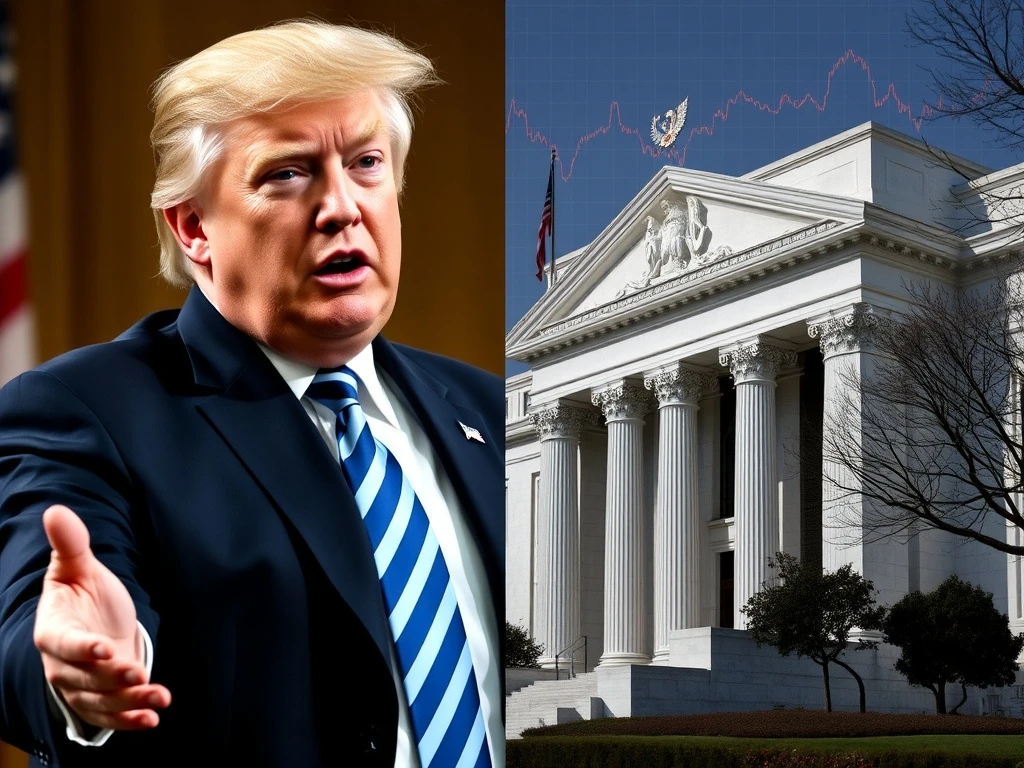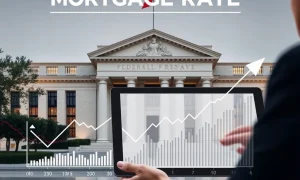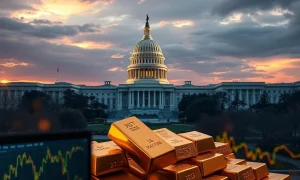“I’m confused!” This sentiment often echoed when former President Donald Trump repeatedly called for a **Trump rate cut** from the Federal Reserve. Many observers wondered why a president, especially one presiding over a seemingly robust economy, would so aggressively demand lower interest rates. This persistent pressure marked a significant deviation from traditional presidential-Fed relations. Indeed, it sparked considerable debate among economists, policymakers, and the public. Understanding this dynamic requires a deep dive into economic principles, central bank independence, and political strategy. We will explore the reasons behind the former president’s fervent desire for a **Trump rate cut**.
Understanding the Trump Rate Cut Push
Former President Trump consistently urged the Federal Reserve to lower its benchmark interest rate. He believed this action would further boost the U.S. economy. His public statements often criticized the Fed’s policies, particularly its decision to raise rates in the early part of his term. Trump viewed these rate hikes as detrimental to economic growth and global competitiveness. Therefore, he vocally advocated for a significant **Trump rate cut**.
The Federal Reserve operates as the central bank of the United States. Its primary roles include managing monetary policy, ensuring financial stability, and providing banking services. The Fed aims for maximum employment and stable prices, often referred to as its dual mandate. Interest rates are a key tool in achieving these goals. Higher rates can slow down an overheating economy. Conversely, lower rates can stimulate economic activity. Trump’s demands placed the Fed’s independence under unprecedented scrutiny. This situation highlighted the tension between political desires and economic realities.
The Federal Reserve’s Mandate and Independence
The Federal Reserve’s independence is a cornerstone of its effectiveness. Congress established the Fed as an independent agency to insulate monetary policy decisions from short-term political pressures. This structure allows the Fed to make decisions based on economic data and long-term stability. For instance, its Board of Governors members serve fixed terms. They are not easily removed by a president. This independence is crucial for maintaining public trust in the currency and financial system. It also helps prevent inflationary spirals or politically motivated booms and busts. The Fed’s actions, whether a rate hike or a **Trump rate cut**, are meant to serve the nation’s economic health.
Economic Rationale Behind the Trump Rate Cut Calls
President Trump presented several economic arguments for a **Trump rate cut**. First, he often cited the strength of the U.S. dollar. A stronger dollar makes American exports more expensive. This can hurt U.S. companies competing in global markets. Lower interest rates, he argued, could weaken the dollar. Consequently, American goods would become more competitive internationally. This would boost exports and support domestic industries.
Furthermore, Trump frequently pointed to the low inflation environment. Typically, central banks raise rates to combat rising inflation. However, inflation remained relatively subdued during much of his presidency. He suggested that with low inflation, there was no risk of the economy overheating. Therefore, the Fed had ample room to cut rates without causing price instability. He also highlighted that other major global economies, like Europe and Japan, maintained very low or even negative interest rates. This created a perceived disadvantage for the U.S. He believed a **Trump rate cut** would level the playing field.
Impact on the Economy and Markets
A **Trump rate cut** could indeed have several impacts on the economy. Lower interest rates generally reduce borrowing costs for consumers and businesses. This can stimulate spending and investment. For example, mortgage rates might fall, making homeownership more affordable. Businesses could access cheaper loans for expansion, leading to job creation. Moreover, lower rates often make stocks more attractive compared to bonds. This can fuel stock market rallies. Such market gains could create a positive wealth effect. Consumers might feel wealthier and spend more. However, excessively low rates can also lead to asset bubbles. They can also reduce returns for savers. The former president, however, prioritized growth and market performance. He believed a **Trump rate cut** was a necessary catalyst for these outcomes.
The Fed’s Stance and Counterarguments
Despite President Trump’s consistent calls for a **Trump rate cut**, the Federal Reserve maintained its independent stance. Fed officials, including then-Chair Jerome Powell, repeatedly emphasized their commitment to a data-driven approach. They focused on economic indicators like employment, inflation, and global economic conditions. The Fed’s cautious approach stemmed from a desire to avoid overheating the economy. They also wanted to preserve their ability to respond to future downturns. Cutting rates too quickly or too deeply could leave them with less ammunition during a recession. Furthermore, the Fed aimed to normalize interest rates after years of near-zero rates following the 2008 financial crisis. This normalization process provides flexibility for future policy actions. Therefore, they often resisted immediate, sharp rate reductions.
Historical Context of Presidential-Fed Relations
Tensions between presidents and the Federal Reserve are not new. Historically, presidents have sometimes expressed dissatisfaction with Fed policy. For instance, President Lyndon B. Johnson reportedly confronted Fed Chair William McChesney Martin over rate hikes during the Vietnam War. President Richard Nixon also pressured Fed Chair Arthur Burns for looser monetary policy. However, President Trump’s public and often aggressive criticism was widely seen as unprecedented. He frequently used social media and public rallies to voice his demands for a **Trump rate cut**. This direct and very public pressure challenged the traditional norms of central bank independence. It created a unique political and economic dynamic. This made the debate over a **Trump rate cut** particularly intense.
Political Motivations for a Trump Rate Cut
Beyond the economic arguments, strong political motivations likely underpinned President Trump’s desire for a **Trump rate cut**. A booming economy is often seen as a significant advantage for an incumbent president seeking re-election. Lower interest rates could potentially boost economic growth and employment. They could also contribute to a rising stock market. These factors generally correlate with higher approval ratings. Trump often highlighted economic performance as a key achievement of his administration. He therefore saw a **Trump rate cut** as a tool to further enhance these metrics. This would bolster his re-election campaign. Furthermore, lower rates might appeal to key voting blocs. For example, homeowners could benefit from cheaper mortgages. Businesses might appreciate lower borrowing costs. These benefits could translate into political support. Therefore, the calls for a **Trump rate cut** were not solely about economic theory. They also involved strategic political calculations.
The Outcome of the Rate Cut Debate
Despite President Trump’s sustained pressure, the Federal Reserve ultimately made its own decisions. The Fed did implement a series of rate cuts in 2019. However, these cuts were primarily in response to slowing global growth and trade tensions. They were not explicitly a direct capitulation to presidential demands. The Fed framed its actions as precautionary measures to sustain the economic expansion. The central bank emphasized its commitment to its dual mandate. It consistently reiterated its independence. This period highlighted the delicate balance between political influence and central bank autonomy. The intense public debate surrounding the **Trump rate cut** demands underscored the importance of this institutional independence for economic stability. Ultimately, the Fed navigated a challenging period. It balanced political scrutiny with its mandate to manage the nation’s monetary policy effectively.
In conclusion, the confusion surrounding President Trump’s fervent calls for a **Trump rate cut** stemmed from a complex interplay of economic theories, institutional independence, and political ambition. His arguments centered on boosting competitiveness and growth in a low-inflation environment. However, the Federal Reserve maintained its focus on long-term stability and data-driven decisions. This dynamic showcased the ongoing tension between a president’s desire for immediate economic gains and a central bank’s mandate for prudent, independent monetary policy. The debate left a lasting mark on the relationship between the White House and the Federal Reserve.
Frequently Asked Questions (FAQs)
Why did President Trump want a Trump rate cut so badly?
President Trump believed a **Trump rate cut** would further stimulate the U.S. economy. He argued it would weaken the dollar, making American exports more competitive globally. He also felt that with low inflation, there was no risk in lowering rates. This would boost economic growth and help his re-election prospects.
What is the Federal Reserve’s primary role regarding interest rates?
The Federal Reserve’s primary role is to manage monetary policy. It aims to achieve maximum employment and stable prices (low inflation). It uses interest rates as a key tool. Lowering rates stimulates economic activity. Raising rates helps to cool an overheating economy.
How does a Trump rate cut affect the average American?
A **Trump rate cut** can impact average Americans in several ways. Lower rates mean cheaper borrowing costs for mortgages, car loans, and credit cards. This can make major purchases more affordable. However, it can also reduce returns on savings accounts and fixed-income investments.
Is the Federal Reserve truly independent from the President?
Yes, the Federal Reserve is designed to be an independent agency. Its Board of Governors members serve staggered terms. This structure helps insulate monetary policy decisions from short-term political pressures. This independence is crucial for long-term economic stability and trust.
Did the Federal Reserve eventually cut rates during Trump’s presidency?
Yes, the Federal Reserve did implement a series of rate cuts in 2019. However, the Fed stated these cuts were in response to slowing global growth and trade tensions. They emphasized that their decisions were based on economic data and their dual mandate, not political pressure.








